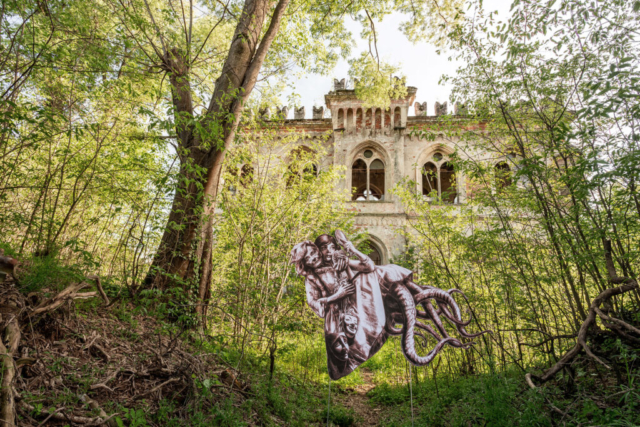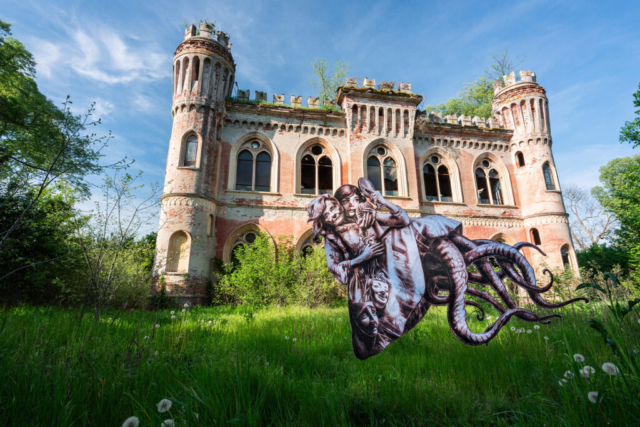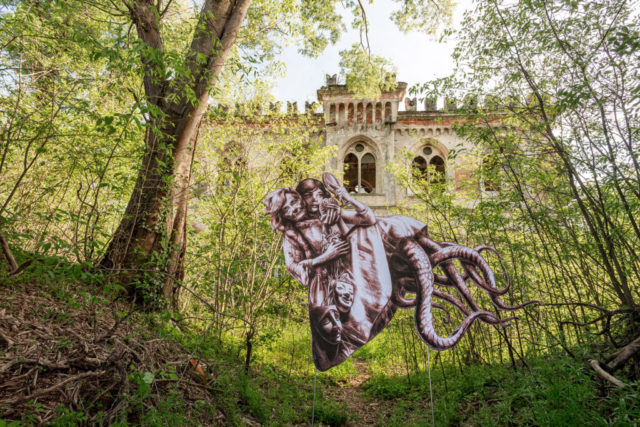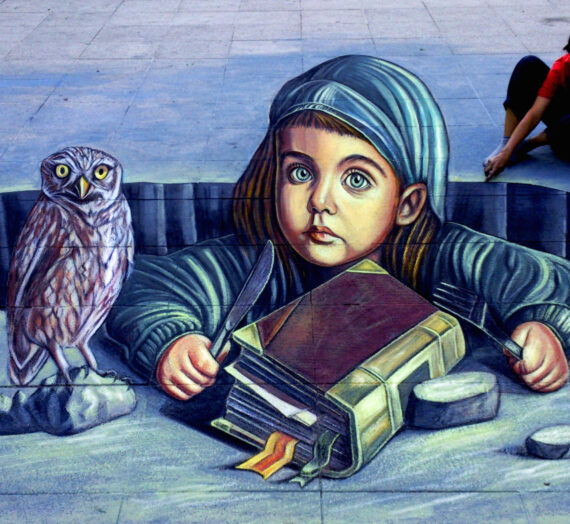Quest’opera – Algoretica – è nata da una riflessione sull’intelligenza artificiale e sulle spirali di pensiero che vi si abbarbicano, sulla complessità e la sintesi, sull’antipatia che genera, sui timori che alimenta.
A installazione terminata però mi sono resa conto di aver creato un pezzo che è al contrario tremendamente barocco, pura malinconia di un animo grottesco. Ve l’ho chiesto e ne sono uscite varie interpretazioni, nessuna legata al tema dell’intelligenza artificiale.
Ho proprio sbagliato strada, credevo, ma mi sono domandata perché fossi approdata così lontano dal mio obiettivo.
Certamente influenzata da un recente saggio di Aurelio Musi, pensavo di essere stata affascinata da altri mondi per il motivo stesso della mia inesperienza digitale. Mi sono poi ricordata però di come i sogni dell’epoca barocca, così come interpretati da Benjamin nei suoi Passages, avessero evocato gli universi digitali della contemporaneità.
Chi coniò la parola barocco lo fece con intento dispregiativo, per definire un’età che appariva ai suoi occhi posteri come oscura e complessa, un’epoca nella quale l’arte, la letteratura e la musica degenerano in stramberie eccentriche. Per fortuna, dico io.
Il lavoro di Buci-Glucksmann ha collegato la folie du voir dell’arte barocca con la fervente impresa scientifica del XVII secolo: l’universo stesso diviene a sua volta fantasmagoria, lo sguardo vuole abbracciare tutto l’esistente e superarne le contraddizioni. Tutto conta in una natura ossimorica.
Forse Algoretica ricorda proprio, con la ricerca di una teatralità immersiva in un luogo abbandonato, gli apparati effimeri seicenteschi. Intende mostrare la bellezza dell’inganno dell’intelligenza artificiale con l’ambiguità dell’illusione. Due figure in una, un contraltare di atteggiamenti, un doppio che condivide arti, un Giano che pondera pensieri e sentimenti. La ricerca di una giovinezza eterna, l’impossibilità di una reale comprensione di sé e del tutto.
In fondo, occupandomi di immagini anamorfiche, non potevo far altro, nel tentativo di capire l’artificio digitale, che approdare al barocco. Addirittura scontato come filo rosso, non avevo adorato forse l’Ars magna lucis et umbrae?
Ma c’è di più. Ciò che rende l’ambiguità barocca più profonda di una classica dicotomia bene / male, è l’assenza di un giudizio morale, la mancata antitesi fra verità e illusione.
Forse qui si ferma il mio giudizio sugli infiniti mondi dell’intelligenza artificiale, ne percepisco il gusto amaro ma resto travolta dalle sue possibilità e affascinata dai suoi trabocchetti, confusa dalle ambizioni della società degli algoritmi, intimorita dall’onniveggenza e dalla guerra automatica.
Avevo appena finito di scrivere queste righe quando ho trovato un testo illuminante di Alessandro Longo che collega abilmente il fervore barocco alla hubris algoritmica, considerando i nuovi programmi e dispositivi come protesi della razionalità umana in maniera simile ai microscopi e ai telescopi. Cito da lui:
“Come nelle figure anamorfiche dell’arte barocca, la raffinazione della vista macchinica ha portato con sé nuove allucinazioni visive e statistiche: i nostri database sono ricchi di pregiudizi, per esempio, e le etichette che gli algoritmi apprendono ereditano questi tristi insegnamenti. Ma, soprattutto, queste macchine non hanno davvero raggiunto uno sguardo d’insieme e basta ancora poco per ingannarle. Le illusioni ottiche dello sguardo macchinico si chiamano tecnicamente adversarial examples: si tratta, secondo la definizione di OpenAi, di input per il machine learning costruiti ad hoc per ingannare la macchina. Quando una macchina «vede», lo fa riconoscendo attraverso una serie di calcoli i pixel di ciascuna immagine. Una variazione di questi pixel, se fatta nel «posto giusto» e pur rimanendo invisibile all’occhio umano, è in grado di far fallire miseramente lo sguardo macchinico.”
Penso quindi che se si tratta di potentissimi strumenti l’unico pericolo sta nel fine per il quale verranno usati e in quali ambiti. Questa nuova follia del vedere (automatizzata) va presa a piccole dosi e consapevolmente. Se il fine è il potere, se il mezzo è la guerra dei droni, se lo scopo è l’omologazione del pensiero, allora voglio svegliarmi da questo incubo distopico (e miserrimo).
Tutte le fotografie sono di Andrea Zampatti.
This work – Algoretica – was born from a reflection on artificial intelligence and the spirals of thought that cling to it, on complexity and synthesis, on the antipathy it generates, on the fears it fuels.
Once the installation was finished, however, I realized that I had created a piece that is, on the contrary, terribly baroque, pure melancholy of a grotesque soul. I asked you and various interpretations emerged, none linked to the theme of artificial intelligence.
I really took the wrong path, I thought, but I asked myself why I had landed so far from my goal.
Certainly influenced by a recent essay by Aurelio Musi, I thought I had been fascinated by other worlds for the very reason of my digital inexperience. But then I remembered how the dreams of the Baroque era, as interpreted by Benjamin in his Passages, had evoked the digital universes of contemporaneity.
Whoever coined the word baroque did so with a derogatory intent, to define an age that appeared to his later eyes as dark and complex, an era in which art, literature and music degenerate into eccentric oddities. Fortunately, I say.
Buci-Glucksmann’s work has linked the folie du voir of baroque art with the fervent scientific enterprise of the seventeenth century: the universe itself becomes a phantasmagoria, the gaze wants to embrace all that exists and overcome its contradictions. Everything counts in an oxymoronic nature.
Perhaps Algoretica recalls, with the search for an immersive theatricality in an abandoned place, the ephemeral apparatuses of the seventeenth century. It intends to show the beauty of the deception of artificial intelligence with the ambiguity of illusion. Two figures in one, a counterpart of attitudes, a double that shares limbs, a Janus who ponders thoughts and feelings. The search for eternal youth, the impossibility of a real understanding of oneself and of the whole.
Ultimately, dealing with anamorphic images, I could not help but land on the baroque, in an attempt to understand the digital artifice. Even taken for granted as a common thread, hadn’t I perhaps adored the Ars magna lucis et umbrae?
But there’s more. What makes the baroque ambiguity deeper than a classic good/evil dichotomy is the absence of a moral judgment, the lack of antithesis between truth and illusion.
Perhaps this is where my judgment on the infinite worlds of artificial intelligence ends, I perceive its bitter taste but I remain overwhelmed by its possibilities and fascinated by its pitfalls, confused by the ambitions of the algorithmic society, intimidated by omniscience and automatic war.
I had just finished writing these lines when I found an enlightening text by Alessandro Longo who skillfully connects baroque fervor to algorithmic hubris, considering the new programs and devices as prostheses of human rationality in a similar way to microscopes and telescopes. I quote from him:
“As in the anamorphic figures of baroque art, the refinement of machine vision has brought with it new visual and statistical hallucinations: our databases are full of prejudices, for example, and the labels that algorithms learn inherit these sad teachings. But, above all, these machines have not really achieved an overall view and it still takes little to fool them. The optical illusions of the machine gaze are technically called adversarial examples: they are, according to the OpenAi definition, inputs for machine learning built specifically to fool the machine. When a machine “sees”, it does so by recognizing the pixels of each image through a series of calculations. A variation of these pixels, if done in the “right place” and while remaining invisible to the human eye, is capable of causing the machine gaze to fail miserably.”
I therefore think that if these are very powerful tools, the only danger lies in the purpose for which they will be used and in which areas. This new madness of (automated) seeing must be taken in small doses and consciously. If the purpose is power, if the means is drone warfare, if the aim is the homologation of thought, then I want to wake up from this dystopian (and miserable) nightmare.
PH. by Andrea Zampatti.








